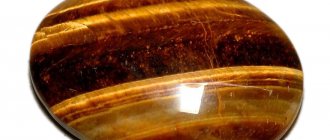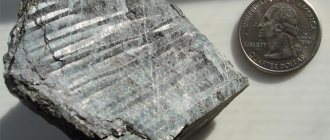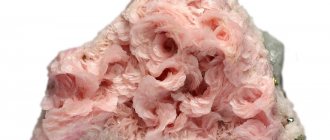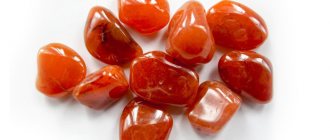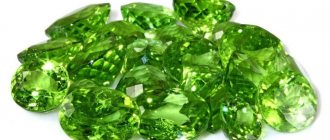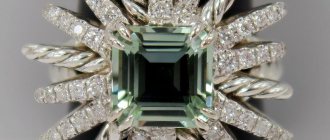Garnet is not a single gemstone, but is a group of several closely related minerals. All types of garnets have similar physical properties and crystal forms, but differ in chemical composition.
Garnets are non-silicates with the general formula X3Y2(SiO4)3. The X field is usually occupied by divalent cations (Ca, Mg, Fe, Mn)2+, and the Y field by trivalent cations (Al, Fe, Cr)3+ in an octahedral/tetrahedral structure with [SiO4]4. Garnets are most often found in the shape of a dodecahedron, but also in the shape of a trapezoid.
Because the chemical composition of garnet varies, the atomic bonds in some varieties are stronger than others. As a result, this group of minerals has a Mohs hardness range of approximately 6.5 to 7.5.
Historical reference
Already by the beginning of the 16th century, several varieties of garnets were distinguished in Russia, and until the 19th century, two main names were assigned to them: “bechet” and “garnet,” which they tried to correctly identify and separate from other, more expensive varieties of red transparent gems. The “Trading Book” directly warned merchants: “Do not buy bechet for lal. The nobility is drawn to the color: it’s like bubbles.” Or here’s another recommendation from the same “Trading Book”: “And take care that they don’t sell you wine for lal; and the vinisa stone is red, and its color is liquid.”
Here both varieties of garnet are mentioned in contrast to lalu, which in those days was the name given to red noble spinel, a stone rarer and more expensive than pyropes or almandines.
Sasanian intaglio made of garnet - with a portrait of the Shah and a Pahlavi inscription: “Mazdean lord Shapur, Shahinshah of Eran.”
The word “venisa” (or vinisa) mentioned several times above comes from a distorted (Russified) Persian “benefse”, which means purple. Even Al-Biruni in his “Mineralogy” more than once noticed that the red color of garnets is not without a violet (lilac) tint. And in fact, under different lighting conditions, the color can change from fiery red to almost purple.
As for “bechet” (or becheta), its name goes back to the Arabic name for almandine garnets - “bijazi”. At one time, the medieval scholastic scholar Albertus Magnus, at his own discretion, translated the Arabic word “bijazi” into learned Latin as “granatus,” in other words, grainy. Thus, he emphasized the characteristic feature of natural garnetites. Their red (or not red) fused crystals often resemble juicy pomegranate fruits. The same “trading book” said: “... when a stone sweeps, it cheers up the heart and drives away sadness and inappropriate thoughts, increases reason and honor...”
Under the unifying name of “worm-like yacht” in Rus', a variety of (transparent) red stones were known: among them there was a real oriental ruby, and garnets of all stripes, and there was also Ceylon hyacinth (a brown variety of zircon, which was called iocinthos).
Starting from the 16th century, the bloody Bohemian garnet also came to Rus', which, according to Boethius de Boot, the author of a famous work on stones (1609), was formed from frozen water drops, colored with bloody vapors. Red noble spinel under the name Lala was also in great use among our ancestors, who did not mix this stone with yakhont.
Lomonosov also warned that red gems can be born in the depths not only in the hot south or the shores of the Indian Ocean, but also in the cold north of Russia, in particular, in the homeland of Lomonosov himself.
Less than a hundred years had passed before his predictions came true brilliantly. Already in 1805, the famous Russian mineralogist Vasily Mikhailovich Severgin, describing cherry “Kidel garnets” (almandine garnets) in his works, noted that they (carried out by the waves) were very often collected by local children along the shores of Lake Ladoga.
The Kola Peninsula is also very rich in almandines. In particular, Academician Fersman writes that in 1920, in quarries near Murmansk, he himself had the opportunity to discover fairly pure, although light-colored, samples of almandines.
Physical and chemical properties
Garnet crystal
From the point of view of physicists, chemists and geologists, all minerals of the garnet family are distinguished by a complex molecular structure. The basis is silicon oxide in combination with various metals - mainly iron, manganese, magnesium, and less often aluminum and chromium. A separate group of garnets contains calcium and metal compounds.
The color of the crystal depends on the metal impurities. Iron gives a red color, manganese gives a yellowish color, aluminum lightens the color, and an admixture of titanium makes it black. Calcium garnets are mostly yellow or green.
Differences in the chemical composition have little effect on the properties of pomegranate; they are approximately similar in all types. This stone has a hardness of up to 7.5 Mohs, a vitreous luster and a medium density.
| Formula | X3Y2Z3φ12, where X are elements in the dodecahedral position; Y – elements in octahedral position; Z – elements in tetrahedral position; φ – O, OH or F |
| Color | Very rarely colorless; mostly painted in different colors, with the exception of blue |
| Shine | Glass, greasy, resin, diamond |
| Transparency | Transparent, translucent, see-through |
| Hardness | 6 6,5 7 7,5 |
| Cleavage | Not visible |
| Kink | Conchoidal, uneven |
| Density | 3,4 — 4,3 |
A little about the stone
People have been using pomegranate for thousands of years. For the first time, the ancient Romans, Greeks, Persians and Scythians began creating jewelry with the mineral. Over such a long history, the stone has changed many names. In Europe, jewelers began to use garnet stone only in the seventeenth century. His popularity quickly grew.
Garnets are a natural stone belonging to the silicate class. The hardness of the stone on the Mohs scale reaches 6.5-7.6 units. Green garnets – tsavorites and demantoids – are of great value. In appearance, they closely resemble emeralds due to their color and shine, but their size does not exceed two carats.
The shape of a stone in nature can be completely different. The edges can be varied and have the shape of a trapezoid or triangle. In addition, the mineral can form complex crystals with 48, 36 and 72 faces.
Among the main properties of garnet stone, it is worth highlighting the following:
- Greater mechanical strength.
- Chemical and thermal strength.
- Reduction in the speed of sound when passing through a mineral.
Place of Birth
Almandine from Brazil
Pomegranate mining sites are scattered all over the world. Every corner of the Earth hides one of the varieties of the mineral. Pyrope is often mined together with diamonds, since the mineral occurs among diamond-bearing rocks. Yakutia (Russia) and the South African Republic (South Africa) can boast of such deposits.
The most valuable almandine used by jewelers is found in the following places:
- Russian Federation, deposits on the Kola Peninsula, as well as in Karelia.
- USA.
- Ukraine.
- Brazil.
- Island of Madagascar.
Crystals of such varieties as andradite and hessonite are mined in Dashkesan (Azerbaijan), in Primorye, and also in Chukotka. A rare, emerald green variety of uvarovite agate is found in the Urals, Canada and Finland.
What colors are there?
Pomegranate and the description of each type is determined by the ratio of chemical elements in the composition. Red stones are garnets, green stones are olivines. There are minerals of other shades, as well as garnet with a change in color.
Red
The most common color in the world and familiar to everyone. The brightest, fiery deposits are found in the extreme north and extreme south of the planet: in Yakutia and South Africa. In the mines, these precious stones coexist with diamonds. Other shades: pink, yellowish, brownish, even purple.
Green
Pebbles of pure green color are called grossulars (from the Latin “grossularia” - gooseberry). The colors range from light green to green-brown, indeed, reminiscent of fruits of varying degrees of ripeness. Deposits of the Urals produce emerald green and transparent green crystals.
Black
Instances of this color come in two types:
- opaque red, with a dark matte tint and edges without reflections;
- from a deposit of shorlomite rocks, with a clear metallic luster.
Transparent
All types are considered precious. The colorless stone is revered by jewelers and collectors. It is sometimes called leucogranate or white garnet.
Blue
Until the 90s of the last century, it was believed that blue garnet was a myth. But in Madagascar they found a Belikian garnet with a color change that had an alexandrite effect. It changes from blue-green to reddish-purple.
Varieties of pomegranates
The main feature of classic garnets is the red color of all shades. These minerals are not completely transparent; a slight haze is visible in them.
The color of some specimens is purple, black, greenish.
Pomegranate has 14 varieties, the most common of which are:
- pyrope - dark red;
Pyrope
- almandine - red, brown, there are purple samples;
Almandine garnet Madagascar
- spessartine - orange, pink, yellowish-brown;
Spessartine
- grossular (the name is translated from Latin as “gooseberry”) - greenish-brown or light green;
Grossular 15x15x18 mm. Yakutia
- uvarovite - emerald color, very rare;
Uvarovite crystals from the Saranovskoe deposit, Middle Urals
- hessonite - its color resembles honey;
Hessonite stone
- andradite - yellow, greenish, red;
Andradite crystals
- melanite - black (this is a type of andradite);
Melanitis from Kazakhstan
- leucogranate is a transparent mineral (more used in industry).
Leucogranate
Garnet of “unusual” color is not easy to distinguish from other gems. This can only be determined with the help of laboratory methods.
Interesting Facts
In nature there is an amazing variety of pomegranate called formic. Bright red crystals have certain physical and chemical properties. They can only be found on the surface of termite mounds.
You probably don’t know that very miniature grenades are used in mechanical watches. They are used to secure parts that are subject to friction. It is believed that the more natural minerals in the mechanism, the longer it will last.
At age 70, Goethe fell in love with an 18-year-old aristocrat named Ulrike von Lewetzow. He ordered jewelers to make a garnet set for the girl, which contained 460 stones of the highest quality.
Healing properties
Natural grossular bracelet
Healing qualities are mainly attributed to the red varieties of this stone - pyrope and almandine, since these are the most ancient known subspecies of garnet.
Less often they talk about grossular.
The importance of garnet in lithotherapy is great, but you need to be aware that in most cases this does not mean any stones, but red ones. And their main property is based on the ancient rules of sympathetic magic. This means that like influences like - red as blood, the garnet has power over blood.
It means that:
- pomegranate can stop wound bleeding;
- it promotes accelerated regeneration;
- it normalizes blood pressure.
In addition, wearing a garnet in gold is beneficial for health as a preventive measure against colds - it prevents many pulmonary diseases. A stone set in silver is suitable for people who have weak immunity and, due to this, an increased risk of contracting a sore throat, pneumonia or other infectious diseases.
Pomegranate is able to give its owner vigor and vitality to cope with almost any illness or stress.
Some lithotherapists recommend wearing a gold garnet ring on the middle finger of the right hand as a way to relieve pain from frequent migraines.
Magical properties of pomegranate
Pomegranate is a talisman for people endowed with a strong character and who see a clear goal. At the same time, determination must carry good intentions, otherwise the stone will play according to the principle “don’t dig a hole for someone else - you yourself will fall into it.” The pomegranate will lead a wicked person into the traps he has set, depriving him of all material benefits, driving him to madness.
Pendant with uvarovite
The gem supports a person in all his aspirations to bring something new into the world, developing his own business. Garnet loves creative people who stubbornly follow the intended path, constantly working on themselves.
A person who has hope for the protection of pomegranate must have a clearly defined goal without any hesitation. Absent-mindedness will lead to confusion in the amulet, which will begin to move the owner in different directions, and sometimes cause illness.
Garnet is the patron saint of lovers. Men who want to show the sincerity of their intentions are recommended to give their beloved jewelry with this stone. For those who have lost hope for reciprocity or have lost their former ardor of feelings, the gem will help revive love and improve relationships between lovers.
The mineral will have a beneficial effect on a person of any profession who is an innovator. However, most of all, the stone favors musicians, sculptors, artists, that is, everyone associated with creativity. Pomegranate will provide these people with a surge of inspiration to create new masterpieces.
It is worth noting that not every person can make friends with this mineral. For some, such a tandem can become fatal. And the whole point is that the ancient stone helps to awaken the bestial nature in a person, giving rise to aggression.
This can be useful for infantile, timid individuals, because often people with talents and charisma lack the courage and perseverance to achieve what they want. This is where the pomegranate talisman will come to the rescue. However, by nature, aggressive natures that hide the “inner beast” are better off not wearing such amulets, so as not to become a real monster.
Why do you dream of pomegranate?
Ring with hessonite
Garnet is considered a symbol of love, passion, strong emotions, jealousy and great love affairs. And if you dream of a garnet stone, then be sure that soon something will change greatly on your love front.
If you dreamed that you were putting on a ring with a garnet, a whirlwind romance will soon happen in your life. Rest assured, you will get a lot of emotions and experience indescribable feelings.
In a dream, you are wearing garnet earrings - you will soon get married or relationships in your family will improve for the better.
Remove jewelry from your ears - expect changes: you may need to reconsider your relationship with your loved one and make some compromises.
If you dreamed that you were given jewelry with a pomegranate, a person will soon appear in your life who will bring you great benefit in your personal life. For example, your friend will introduce you to her life partner. Or a person will appear at work with whom you will begin a pleasant love relationship. In any case, expect changes.
Pomegranate care and cleaning
Garnets are quite hard and durable, although the hardness of each stone varies depending on its type. For example, demantoid is softer than almandine, pyrope, spessartine and tsavorite. Proper care of stones includes protecting them from strong impacts that could cause damage to them. Cleaning the stones is as simple as using a soft cloth and warm, soapy water. Soap must be rinsed off thoroughly! As with most stones, ultrasonic and steam cleaners are not recommended. Always remove any jewelry before exercising, cleaning, or other physically active activities. Store garnets separately from other stones to avoid scratches. It is best to store them wrapped in soft cloth or in soft boxes.
Talismans, amulets, amulets
Since ancient times, people have used amulets made from this gem. For example, every traveler tried to take a garnet ring or pendant on the road.
The pomegranate is considered an amulet that can both preserve and win the love of another person. Scandinavian legend says that the miniature Ogren, having fallen in love with Freya, the goddess of love, forged a beautiful necklace in order to achieve her favor.
Another property attributed to pomegranate is especially important for men. It symbolizes masculinity, fortitude, and courage.
Many warriors wore jewelry made from this mineral, as it was considered a strong amulet that protected against wounds and death in battle. They inlaid weapons, armor, and helmets. And during the Crusades, almost every knight had a ring with a garnet, designed to protect it in battle.
Important!
Products made from garnet have very strong energy, because of this you should not wear it continuously, you should remove it from time to time and let it “rest”.
Myths and legends
Very often, pyrope is not even called garnet, but Czech (Bohemian) ruby. This inconsistency is due to the fact that the first samples of an unusual mineral, a scattering of fiery red stones, were found in the mountains of the Czech Republic by simple peasants. This happened during the Middle Ages, in the 10th century. In 1546, the alchemist, warlock Gregory Agricola, conducted experiments with a gem, which, when exposed to sunlight or reflections from a candle, flared up with a bright flame, and in the shadows or under weak artificial lighting it became purple-black. It was he who called it pyrope, that is, similar to fire, from the Greek word pyr - fire.
In 1803, the scientist geologist and mineralogist Werner Abraham Gottlob (Germany) studied the properties of a sample of Czech garnet. It was he who isolated it as a separate type of mineral and gave it the official (scientific) name pyrope - pyrope.
However, people knew about this stone before. Even in ancient times, the Hellenes already used the name pyropos to designate it. The Latins called it, like all red stones, a carbuncle, which translates as a smoldering coal. He was associated with the name and power of the god of war, Mars. When Roman legionaries went on a campaign, they always took amulets, talismans, or just pieces of stone with them, so that it would bring them good luck, send them luck and courage in battle.
Among the myths of Ancient Greece there is a story telling about an evil and treacherous echidna woman. She was a beautiful girl, whose lower body resembled a crocodile. A large fiery stone adorned her forehead. The legend said that its owner would be able to find any treasure, no matter how carefully it was hidden. Many knights who tried to steal the stone were killed by an echidna, who ate them along with their armor.
According to another legend that originated in Medieval Europe, pyrope is the frozen blood of a dragon. Having defeated the dragon, the warrior must cut off its head and remove from the skull a luminous blood clot, which immediately solidifies, turning into stone - pyrope. Having given the gem to the lady of his heart, the brave knight could count on her favor. Other warriors decorated their weapons with it: seeing a bright red garnet shining on the hilt of a sword, other knights were afraid to engage in battle with him, because he was able to defeat even a dragon.
Some dishonest people tried to steal the trophy in order to appropriate it for themselves or resell it. But the stone, which was considered a symbol of courage, courage, justice, honor, began to harm the kidnapper, as well as the person who acquired it in such a “dishonest” way.
Our ancestors were also familiar with red stone. Venice or the worm, which “glows at night” and is “visible like coal,” as pyrope was described in the ancient ABC book, came to Ancient Rus' from the Mongols. Galyn Chulu is a stone of fire, Tamerlane’s warriors called it. They considered it the sparks of a volcano, giving strength and courage. Before the battle, they always drank a drink from a bowl decorated with pyrope.
Who is suitable according to the horoscope?
Pendant with andradite garnet
When choosing a stone according to your horoscope, pay attention not only to your zodiac sign, but also to your character traits. You should choose a gem after you have studied the characteristics of your zodiac sign, determined your advantages, disadvantages, as well as the expected effect of this stone on them.
Almandine and pyrope are suitable for Aries, Leo, Sagittarius (although it must be taken into account that it can increase their impulsiveness). But they form the best alliance with Capricorn.
Grossular is a very peaceful stone, suitable for all signs. But, unfortunately, it is not very strong, unlike scarlet garnets.
Impact on zodiac signs:
- Aries. Although the garnet is suitable for assertive representatives of the sign, it should not be worn constantly, so as not to increase temperament and anger, the consequences of which will harm Aries himself. If you follow this advice, the stone will help such a person become more tolerant, softer, and relieve him of unjustified suspicion. By improving his character, a person will find reliable friends and true love.
- Twins. This stone helps to develop and improve. For those of them who are fickle in their passions, moods, and who adore change, it will give them a desire for constancy, thereby harmonizing the owner’s personality. Excessive impulsiveness and the tendency to get into arguments will be moderated.
- A lion. At the beginning of wearing the crystal, its energetic power can increase Leo's temper. Over time, their relationship will become more harmonious, which will have a positive effect on the owner’s character.
- Virgo will become more emotional, this will allow her to experience high feelings. The character of such a person will become more harmonious: rationality and emotionality will be balanced. The habit of getting irritated by little things will go away, and tolerance for other people's shortcomings will appear.
- Scales. The most important for them is the dark red garnet. It gives the energy of fire, self-confidence, and will help in determining the right path in life. A green stone will also be useful.
- Scorpion. A blood-red gem can pacify his contradictory nature; he will direct Scorpio’s natural energy and passion to new achievements, especially in science. A person will have more self-control and willpower, which will contribute to achieving success in life, as well as harmony and love in his environment.
- Sagittarius. Amulets made from this mineral help people of this sign stop acting rashly, become wiser, and more tolerant of other people's opinions.
- Capricorn. For representatives of this zodiac sign, garnet is a lucky stone: it gives energy, promotes professional growth (which is very important for Capricorns), imparts sociability, and helps to find new friends. A person will become less irritated by failures and will move more persistently towards his goals.
- Aquarius. These people have a somewhat contradictory character, their mood can change often. A green specimen (uvarovite or grossular) will help you become constant in your passions and concentrate on achieving an important goal. For dreamy individuals who are constantly in dreams, the gem will help them appreciate real life. The magnetic power of Aquarius, the ability to attract people to your side, will also increase.
- For Pisces and Cancer, the gem will not be useful, because its energy does not at all correspond to their character, habit of doubt and contemplation. Garnet will constantly encourage them to take action, to move forward; such constant pushing and coercion creates severe discomfort, since Pisces value their independence, and Cancer is characterized by caution. Pisces can pay attention to amethyst, opal, rose quartz, jasper, and Cancer - to emerald, pearl, agate, cat's eye, alexandrite. Suitable for both of these signs: moonstone, labradorite, spinel.
- Taurus also has poor compatibility with pomegranate. If he wears talismans and amulets made from this mineral, material difficulties and other troubles may arise. The dynamic energy of the crystal is not suitable for Taurus. Agate, rose quartz, spinel, labradorite, malachite, and carnelian can be a good talisman or amulet for Taurus.
Compatibility with zodiac signs
For representatives of some zodiac signs, red garnet is especially favorable. The meaning of the stone can be as follows:
- Pomegranate gives Capricorns physical and spiritual strength, which allows them to achieve success in all areas of life. The stone allows you to overcome embarrassment and isolation, and also helps to improve your personal life.
- For Scorpios, the stone helps to pacify internal contradictions and stabilize their emotional state. In a relationship, it helps to rekindle passion that has long died out.
- The mineral helps Aquarians overcome inconstancy and find their true life purpose. Pomegranate also returns them from the world of illusions to reality.
- Sagittarius, thanks to this stone, can become more passionate and sensual. It also sharpens intuition and helps avoid troubles.
- Garnet helps Geminis find a foothold and promotes active self-development. It helps overcome the fear of change and gives courage.
- The mineral helps Libra gain self-confidence and make the right decisions. It also helps overcome indecision.
- Virgos, thanks to the stone, find it easier to start new things and become more far-sighted. The stone also helps them find harmony with the world around them.
Who suits the name
Grossular garnet 3.15 carats
It is extremely important to determine in advance, when buying a garnet stone, who this type of jewelry is suitable for and who is not. The element of garnets is fire (especially for pyropes and almandines), as well as earth and water. This stone also has patron planets: the Moon, Jupiter, Venus, Mars and the Sun.
Pomegranate is an excellent life talisman for people with the names:
- Alexandra (only for women - for Alexander men this mineral will be useless);
- Alla;
- Anton;
- Valeria;
- Basil
- Galina;
- Lyudmila;
- Maria;
- Nikita;
- Tamara.
What names is it suitable for?
Anton. Pyrope will stimulate blood circulation, add strength, fearlessness and passion. The significance of the stone is especially great if the boy was raised too cautious or was limited in many ways.
Basil. Almandine has a beneficial effect on the endocrine system and digestion. Pomegranate minerals of this variety bestow passion, cheerfulness, endurance, and courage. They help in love.
Alexandra. A powerful nature, and such a garnet gem can lead to victory by balancing the mind and emotions.
Allah. Almandine will help soften an overly firm character and be more lenient towards people. She will appreciate the properties and meaning of the stone, which will support her intention to move firmly through life.
Galina. For windy natures, a semi-precious stone will help maintain fidelity and stability in the family. At the same time, the owner of the pomegranate will look sexier and more attractive. Gives inspiration to creative people. Helps during childbirth.
Lyudmila. The red-violet stone will help you make the right decisions, and the green one will symbolize the tranquility of the family hearth, which the Lyudmilas value so much.
Maria. A suitable amulet against troubles or sadness. The zodiac sign of Leo suits Mary best: the stone will bring great happiness. Mary will add self-confidence to Scorpio, harmony with the world to Gemini, and guarantee well-being and fidelity to Aries.
Tamara. The magic of the stone will help maintain leadership qualities in the family and at work, which women with this name almost always have.
Compatibility with other minerals
In this matter, everything is not easy for pomegranate. The fact is that different types of this stone belong to different elements. Pyrope, almandine, grossular are Fire stones. But, for example, uvarovite is the stone of Air. Fire and Air are friendly elements, but Fire, unlike Air, does not combine with Earth.
So, you can choose stones that suit each other according to this scheme. All grenades combine with:
- diamond and diamond;
- ruby;
- coral;
- pyrite;
- heliolite;
- rock crystal;
- topaz;
- amethyst;
- carnelian;
- golden beryl.
You should not wear them with Water stones - a mutual contradiction will arise (not so strong in the case of uvarovite).
In jewelry, first of all, avoid combinations of garnet:
- with emerald;
- opal;
- aquamarine;
- moonstone;
- alexandrite;
- pearls;
- tourmaline;
- zircon.
In addition to uvarovite, it should also be used with caution. These include:
- jasper;
- chalcedony;
- agate;
- onyx;
- malachite;
- turquoise;
- obsidian;
- morion.
As well as other opaque minerals.
Areas of application
Garnets are used in the abrasive (garnet skins, powders and grinding wheels) and construction industries (additives to cement and ceramic masses), sometimes as a substitute for sapphire and ruby in instrument making, in electronics (as a ferromagnet).
For the needs of industry, methods are being developed for the synthesis of artificial analogues of certain garnets with specified properties: crystals for lasers.
Mostly ferrous garnets (mainly almandine), less commonly spessartine and andradite, are suitable for the abrasive industry. Of great importance for determining the suitability of garnets in industry are their high hardness, the ability, when crushed, to split into particles with sharp-angled cutting edges, and adhesion to paper and linen bases.
Transparent and translucent, beautifully colored garnets are used in jewelry. Precious stones usually include the following (in increasing order of their value: almandine, pyrope, rhodolite, hessonite, grossular, topazolite, demantoid.
Well-designed crystals, brushes and druses make excellent collectibles.
The most popular are crystals of opaque and translucent almandine of a uniform or zonal structure, colored in dark cherry, brownish-brown and brownish-red colors. The source of such crystals and ores is most often sillimanite-bearing quartz-biotite schists (Kitelya deposits in Karelia, Makzabak on the Kola Peninsula, Russia; Fort Wrangel, USA, etc.) and, to a lesser extent, muscovite-beryl granite pegmatites (Ukraine, Russia; Madagascar; Brazil).
Where are the stones mined?
Much antique jewelry from the second half of the nineteenth century features beautiful scarlet garnets that were mined in the mines of Bohemia. To this day, pyrope, which weighs 468.5 carats, is kept in the royal treasuries of Saxony. And in Dresden, in the Green Vault Museum, a stone the size of a chicken egg is kept. It is called the Colorado ruby. The mineral is mined in Zimbabwe, South Africa, USA, Tanzania, Argentina, Brazil, Mexico and Australia.
Almandine is usually dark red in color. It can be translucent, matte or black. During processing, a star with four rays may appear. The reason for this phenomenon is optical illusion. In ancient times, almandines were used for windows in churches and temples. The name of the breed comes from the name of the city of Albanda in Asia Minor. Currently, stones are mined in India, Brazil, Burma, USA, Australia, Tanzania and Sri Lanka.
Spessartin takes its name from the town of Spessart in Bavaria. The stone has a color from light yellow to fiery red. Bright orange (tangerine) spessartine was discovered in 1992 in Namibia.
Decorations and prices
Garnet is a stone whose jewelry has always been very popular. In the Middle Ages, beads, earrings or a pendant made from this mineral were sure to be in the jewelry box of any woman from a noble class.
Usually this gem is set in gold. However, it also looks good with silver; this combination is especially often used for low-quality garnets. After all, according to jewelry traditions, it is not customary to insert a semiprecious stone into gold jewelry.
Garnet, despite its beauty, is not a very expensive stone.
The price of garnet stones depends on the quality and size and, of course, on the rarity of the color:
- Almandine can be purchased for $30 per carat.
- Rhodolite – $25.
- The cost of pyrope starts from $20.
- Spessartine is considered one of the most expensive garnets. For example, a specimen weighing 4.7 carats is valued at $500.
But the price of a technical quality garnet stone starts from a few dollars per carat - for example, Nigerian stones for industry can be bought for $3-7 per carat.
Many jewelry and handmade websites provide summary tables that indicate the price (in rubles and dollars) for different types of garnet. Thus, earrings with a garnet stone in a gold frame can be purchased starting from $100.
Who is the stone contraindicated for?
In some cases, wearing a red garnet is strictly contraindicated. The stone is not recommended for the following people:
- Apathetic and lazy. If you lead a fairly passive lifestyle, the energy generated by the stone will not be consumed. It will accumulate and then can be turned against you. This can be expressed in poor health, bad mood and even failures in life.
- Physically weak people. If you often feel unwell and quickly become exhausted, then red pomegranate is not for you. His powerful energy will suppress your own even more.
- People in a bad mood and with bad intentions. Garnet is a positively charged stone. Anger and despondency are alien to the mineral, and therefore it can enter into confrontation with its owner.
How to wear jewelry with a guarantor
First of all, you need to take into account the features of purchasing such jewelry:
- It is better to go shopping in bright, sunny weather.
- The decoration must be new, since the garnet tends to accumulate the energy of the previous owner.
- If jewelry with a mineral has been inherited, it is necessary to carry out a procedure for cleaning the stone by soaking it in running water for one day.
When buying jewelry, listen carefully to the voice of your heart. The best compatibility will be with a stone to which you feel attracted. Ideal compatibility will be with a mineral that has not had another host.
As for use, it is recommended to wear a ring with a mineral on the middle finger of the left hand if the product is made of silver. The gold ring is worn on the same finger, only on the right hand. Other jewelry does not have any specific use, other than the compatibility of the stones.
How to recognize a fake
To understand whether this is a natural stone or not, you need to learn a few simple rules that apply to garnets:
- The most distinctive feature is the cut of the stone. Since garnet is a hard gemstone, it is usually given one of the following shapes: princess, round and emerald. And if the cut of the stone is different, and they are trying to prove to you that the garnet they are selling is real, then ask the seller for documents on the stone or offer to conduct an independent examination.
- Sometimes on the tag of jewelry with a garnet insert you can see the inscription “ceramic stone”. This means that your gem is artificial. In some sources it is also called “nano-garnet”.
- Experts say that real garnet without inclusions is very rare and usually demands exorbitant amounts of money for it. Therefore, to distinguish a fake from a natural stone, you should carefully examine the gem. If you do not see any internal defects, inclusions or darkening, then most likely you have an artificial mineral in your hands, but if there are any suspicious points (inclusions, voids, etc.), then you probably have natural stone.
- One of the barbaric but working methods is to put your pomegranate in boiling water. If you see pink marks in the water, then you have a cheap fake that has been pre-painted. The paint dissolved in the hot water and colored it.
- We have already written that according to the Mohs scale, garnet is a very hard stone. Therefore, its authenticity can be easily verified by scratching glass with a stone, which has a hardness of 4-6 units. There should be no traces left on the grenade itself if it is of natural origin, but you will find a scratch on the glass.
- Black, bright blue or emerald green garnets of ideal shape and without inclusions are almost impossible to find in jewelry without a prior special order. And such beauties are very, very expensive. Therefore, if you are offered to buy such luxury for pennies, don’t believe it. They offer you a fake or simply an artificial version of the stone.
History and origin
Descriptions of the mineral are found in the chronicles of Ancient Greece, Rome, Scythia, Arabia, and Persia. In Ancient Rome the stone was called “carbuncle”, the Greeks called it “anfrax”. There is an old Georgian legend about the stone, according to which the great ruler sent his daughter’s chosen one to get him 3 pomegranate fruits, guarded by evil spirits.
Returning from a trip with gifts, the guy gave the fruit to the king, who broke the pomegranate. A scattering of ripe red berries fell from it, immediately turning into precious stones.
Like all gems, the mineral has an ancient history. It can be distinguished from shale rocks, gneiss rocks. Garnets in crystalline schists are rock-forming minerals . Depending on the variety, the color of minerals is given by substances such as salite, iron and copper sulfides, mica, and chlorite.
Artificial pomegranate
Since the late 1930s, the American company has created a separate area of its activity - a department for the research and cultivation of pomegranates. In 1950, H.-S. Yoder re-synthesized grossular. Christophe Michel-Levy grew spessartine and grossular. In 1955, after many years of painstaking work, mineralogists L. Kos and H.-S. Yoder finally successfully synthesized pyrope (a known satellite of diamond) and almandine.
However, this success was, in part, anecdotal. The synthesis of artificial garnets required the most complex technological equipment. The size of the resulting garnets was quite decent; they could be cut into a jewelry insert for a ring. But at cost they were not even gold, but rather platinum. Perhaps, the cost of a trip to India and back (to buy a large natural stone there at the local bazaar) would be lower than one synthetic garnet obtained.
However, the efforts of scientists were not in vain. The main thing is that a powerful foundation was laid for future experiments and research in this area. Work on growing artificial crystals continued.
Artificial pomegranate
Back in the late 1940s, the same Yoder, in collaboration with M.L. Keith, made a discovery, the thread from which led in the other direction. Using chemical analysis, yttrium was discovered in spessartines from some deposits. Yttrium garnet was synthesized. Its hardness turned out to be higher than that of natural garnets. The new synthetic crystal was given the name yttrogarnet by its authors, although the name did not stick. To this day, it continues to be called yttrium aluminum garnet (YAG).
But the technology for growing YAG was still expensive. And experiments began on the artificial growth of YAG crystals. In the end, by the method of errors and trials, it was possible to obtain pure yttrogarnets on an industrial scale using the improved Lichtman-Maslennikov method.
After the American J. Pfann more deeply (in a practical way) developed the theory of the process of zonal crystal purification in 1952, the new method found wide application in the industrial cultivation of synthetic stones (not only garnets).
In the Soviet Union, the leader in the development and production of artificial gems was the famous All-Russian Research Institute for the Synthesis of Mineral Raw Materials (VNIISIMS), located in the city of Alexandrov. Naturally, he was a leader in the production of synthetic garnets of all colors: from traditional deep red and pink, to golden yellow, orange and even green, more similar in color to emeralds.
It was there, at VNIISIMS, that a unique technology for the production of dark blue garnet was developed, protected by several copyright certificates of the USSR.
Sources and literature
- S. Akhmetov. "Conversations on Gemology." - M.: “Young Guard”, 1989. - 237 p.
- Great Russian Encyclopedia: [in 35 volumes] / ch. ed. Yu. S. Osipov. — M.: Great Russian Encyclopedia, 2004—2017.
- Vladimir Filatov Diamond-like // Science and Life. — 2022. — No. 4. — P. 76-80
- Geological Dictionary, T. 1. - M.: Nedra, 1978. - P. 187.
- M. I. Pylyaev. "Precious stones, their properties, locations and uses." - third, significantly expanded. - St. Petersburg: A. S. Suvorina, 1896. - 406 p.
- Mineralogy and petrography. - M.: State Scientific and Technical Publishing House of Literature on Geology and Subsoil Protection, 1958. - P. 89-90.
- A.E. Fersman, “Stories about Gems,” second edition. — Moscow: “Science”. – 1974, 240 pp.
- Facets of a garnet. - M.: Nauka, 1990. - P. 42.
- Article description and properties of pomegranate on the website ru.wikipedia.org.
5 / 5 ( 1 voice )
Deposits of pyrope and how it is formed in nature
Deposits of pyropes are distributed across all continents. The main method of occurrence of the mineral is plutonic activity in the bowels of the earth. Placers on the surface are formed during the destruction of igneous rocks, but they are often found in kimberlite pipes, where the mineral pyrope accompanies diamond deposits.
Photo: BASILOSAURUS Mineral Specimen Store, aliexpress.com
Unprocessed pyrope. Photo: mclewis96996, flickr.com.
Photo: DHX SW CRYSTALS Store, aliexpress.com
Modern crystal mining is carried out on the African, Eurasian and American continents. There are deposits in New Zealand and Australia. Ancient deposits where garnets were found directly on the surface or with shallow burial are located in the Czech Middle Mountains (Kutná Hora or Merunice) and the eastern Azov region (Ukraine). These regions are almost completely depleted, but pyropes of different shades and jewelry value are mined on an industrial scale:
- in Yakutia (Anabar massif);
- in the Southern Urals (Kimpersai);
- in Lesotho and Tanzania (Africa);
- in Argentina and Brazil (South America);
- in the United States in Colorado, Arizona, Kansas, California.
The pink variety of pyrope is mined on the islands of Madagascar and Sri Lanka.
